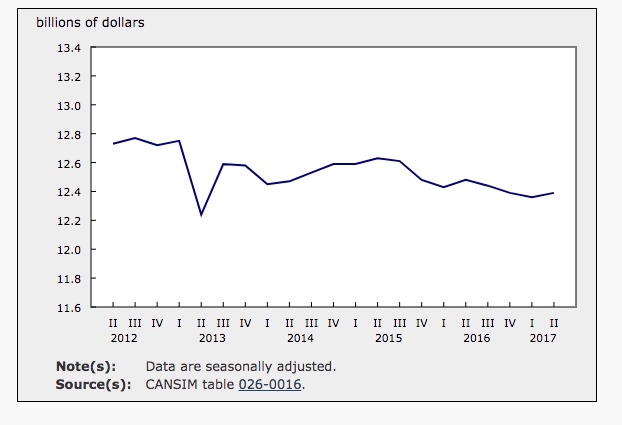
News
Investment in non-residential building construction up in Q2 2017
July 18, 2017 By Statistics Canada
 Chart: Statistics Canada
Chart: Statistics CanadaJuly 18, 2017 – Investment in non-residential building construction totalled $12.4 billion in the second quarter, up 0.3% from the previous quarter. This increase follows three consecutive declines. Nationally, the gain was the result of an increase in spending on the construction of industrial and commercial buildings. The institutional component declined for a second consecutive quarter.
Overall, six provinces posted increases in the second quarter, with Ontario reporting the largest upturn, followed by British Columbia and New Brunswick.
Investment in non-residential building construction
Ontario posted increases in all three components (institutional, industrial, commercial), led by spending on commercial buildings.
In British Columbia, the gain in non-residential construction was mainly the result of higher spending on commercial buildings.
In New Brunswick, non-residential spending in building construction was up 6.6%. The increase was attributable to additional spending on commercial building construction (office and recreational buildings).
Quebec also reported a gain, but it was small (+0.5%), due partly to a strike that affected all construction workers during the final week of May.
The largest decline occurred in Alberta, followed by Saskatchewan. In Alberta, the decrease was mainly the result of lower spending on both institutional and commercial building construction. Despite the decrease in spending, Alberta had the second-highest total spending on non-residential building construction ($2.5 billion), accounting for 20% of total spending for the country. In Saskatchewan, the decrease was primarily the result of lower spending on institutional investment.
Census metropolitan areas
Among the 36 census metropolitan areas (CMAs), 21 saw increased investment in non-residential building construction in the second quarter. Toronto recorded the largest rise, followed by Montréal and Vancouver.
In Toronto, the increase was mainly attributable to an influx in commercial spending, while in Montréal, the increase in spending was mainly the result of an increase in construction of institutional buildings.
The largest declines were reported in Calgary and Edmonton, and in the Ottawa part of the Ottawa–Gatineau CMA. The declines in both Calgary and Edmonton were mainly attributable to commercial and institutional buildings. In Ottawa, the main contributor to the drop was lower spending on construction of commercial buildings.
Industrial component
Investment in industrial projects increased 1.7% to $1.75 billion in the second quarter. At the national level, the increase was attributable to higher investment in the construction of plants for manufacturing and, to a lesser extent, construction of farm buildings and utilities buildings.
Increases were reported in six provinces, with Ontario contributing the most to the overall increase, followed by Alberta.
In Ontario, investment rose 2.9% to $787 million, marking a second straight quarterly gain. Higher spending on plants for manufacturing and on farm buildings were the leading contributors to the gain. The increase in Alberta was mainly the result of higher spending on manufacturing buildings.
In contrast, Quebec posted the largest decline, mainly due to lower spending on maintenance garages and equipment storage buildings.
Commercial component
Spending on commercial buildings increased by 0.4% to $7.2 billion in the second quarter, led by office building and retail building construction.
Investment in commercial projects rose in six provinces, with Ontario posting the largest gain. The growth in Ontario was mainly the result of increased investment in office and recreational buildings.
Conversely, Alberta recorded the largest declines, followed by Saskatchewan. The decrease in Alberta was attributable to lower spending on office and warehouse buildings. In Saskatchewan, the decrease was due to reduced spending on warehouse and recreational buildings, which more than offset increased spending on shopping centres.
Institutional component
In the institutional component, investment fell 0.7% to $3.4 billion in the second quarter. The national decrease was due to a decline in most institutional building types, which more than offset increased spending on educational buildings.
Declines in investment in institutional projects were recorded in five provinces, with Alberta posting the largest drop.
In Alberta, investment fell 6.9% to $701 million in the second quarter. Lower investment in educational buildings and library facilities were primarily responsible for the decline.
The largest increases in institutional building construction were reported in Quebec and Ontario. In both provinces, the advances were led by increases in spending on educational buildings.
Print this page